Container Service for Kubernetes (ACK) provides the alert management feature to allow you to centrally manage alerts that are triggered in different scenarios. You can configure alert rules to get notified when a service exception occurs or one of the following metrics exceeds the threshold: key metrics of basic cluster resources, metrics of core cluster components, and application metrics. You can enable alerting when you create a cluster. ACK allows you to deploy CustomResourceDefinitions (CRDs) in a cluster to configure and manage alert rules. This topic introduces the use scenarios of alert management, and describes how to configure alert rules and how to enable alert management for an ACK cluster.
Background information
The alert management feature allows you to manage the following types of alerts:
Alerts that are triggered by events of cluster exceptions. The event data is synchronized from the event center of ACK. For more information, see Overview of event monitoring.
Alerts that are triggered when the key metrics of basic cluster resources exceed thresholds. The metrics are synchronized from CloudMonitor. For more information, see Monitor basic resources.
Scenarios
ACK allows you to centrally configure alert rules and manage alerts in various scenarios. The alert management feature is commonly used in the following scenarios:
Cluster O&M
You can configure alert rules to detect exceptions in cluster management, storage, networks, and elastic scaling at the earliest opportunity. For example, the following plug-ins are automatically installed when the system creates a cluster:
Use the alert rule set for resource exceptions to get notified when the key metrics of basic cluster resources exceed thresholds. Alerts are triggered when key metrics, such as CPU usage, memory usage, and network latency, exceed the specified thresholds. If you receive alert notifications, you can take measures to ensure cluster stability.
Use the alert rule set for cluster exceptions to get notified of node or container exceptions. Alerts are triggered upon events such as Docker process exceptions, node process exceptions, or pod restart failures.
Use the alert rule set for storage exceptions to get notified of storage changes and exceptions.
Use the alert rule set for network exceptions to get notified of network changes and exceptions.
Use the alert rule set for O&M exceptions to get notified of changes and exceptions that are related to cluster control.
Application development
You can configure alert rules to get notified of exceptions and abnormal metrics of running applications in the cluster at the earliest opportunity. For example, you can configure alert rules to receive notifications about exceptions of replicated pods and when the CPU and memory usage of a Deployment exceeds the thresholds. You can use the default alert rule template to quickly set up alerts to receive notifications about exceptions of replicated pods in the cluster. For example, you can configure and enable the alert rule set for pod exceptions to get notified of exceptions in the pods of your application.
Application management
To get notified of the issues that occur throughout the lifecycle of an application, we recommend that you take note of application health, capacity planning, cluster stability, exceptions, and errors. You can configure and enable the alert rule set for critical events to get notified of warnings and errors in the cluster. You can configure and enable the alert rule set for resource exceptions to get notified of abnormal resource usage in the cluster and optimize capacity planning.
Multi-cluster management
When you manage multiple clusters, you may find it a complex task to configure and synchronize alert rules across the clusters. ACK allows you to deploy CRDs in the cluster to manage alert rules. You can configure the same CRDs to synchronize alert rules across multiple clusters.
Install and update the components
Before you can enable alerting, the ACK console automatically checks whether components need to be activated, installed, or updated.
Log on to the ACK console.
In the left-side navigation pane of the ACK console, click Clusters.
On the Clusters page, find the cluster that you want to manage and click the name of the cluster or click Details in the Actions column. The details page of the cluster appears.
In the left-side navigation pane, choose .
On the Alerts page, the console automatically checks whether the following conditions are met.
If not all conditions are met, follow the on-screen instructions to install or update the required components.
Simple Log Service is activated. If Simple Log Service is not activated, log on to the Simple Log Service console and follow the on-screen instructions to activate the service.
NoteFor more information about the billing rules of Simple Log Service, see Billable items of pay-by-feature.
Event Center is installed. For more information, see Event monitoring.
The alicloud-monitor-controller component is updated to the latest version. For more information, see alicloud-monitor-controller.
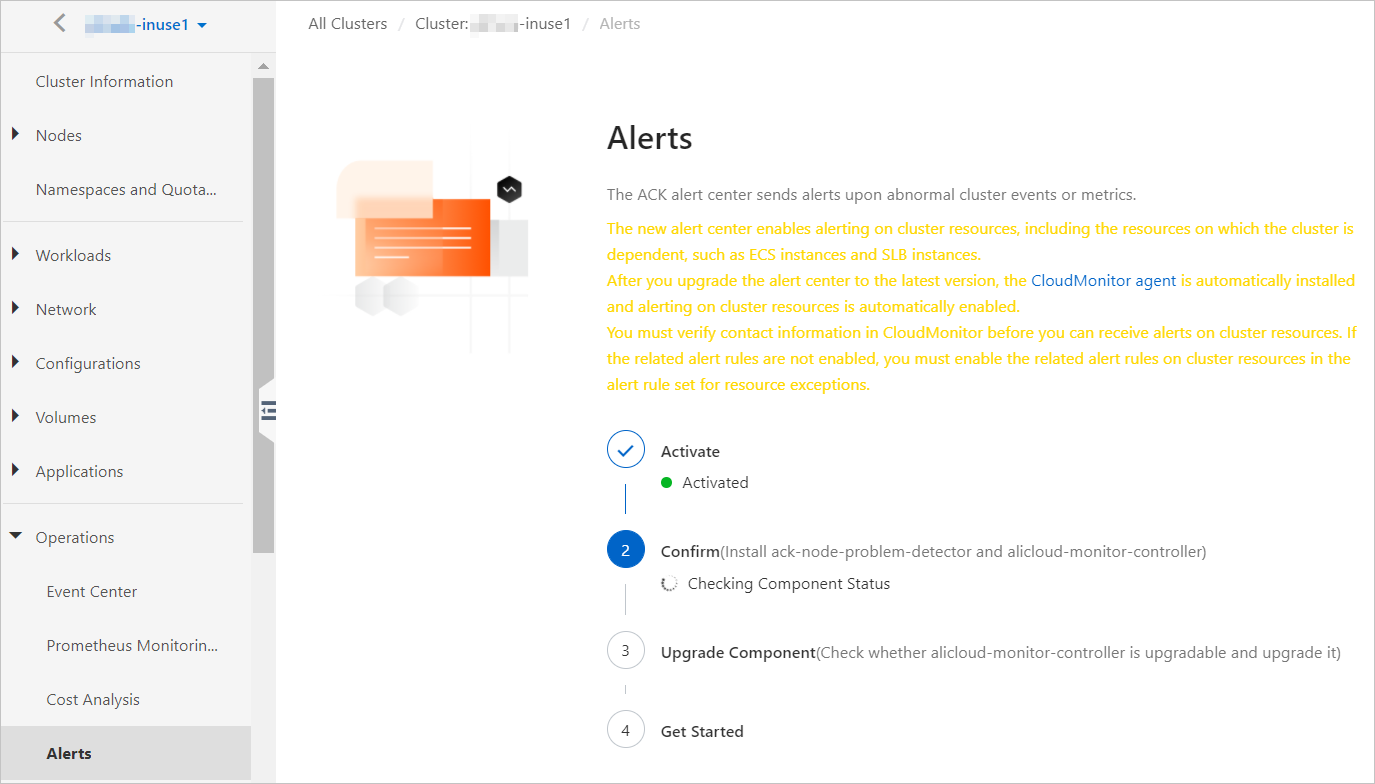
Set up alerting
ACK managed clusters and ACK dedicated clusters support the alerting feature.
Step 1: Enable the default alert rules
When you create an ACK managed cluster, select Use Default Alert Rule Template and specify an alert contact group.
After you select this option, the system automatically creates default alert rules and sends alert notifications to the specified contact group.
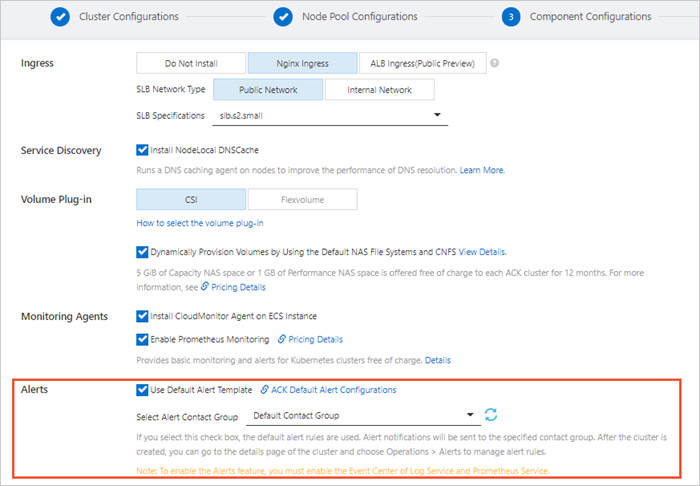
For more information, see Create an ACK managed cluster.
To set up alerting for an existing cluster, you can enable alert rules for the cluster.
In the left-side navigation pane, choose .
On the Alert Rules tab, select an alert rule set and turn on Status to enable the alert rule set.
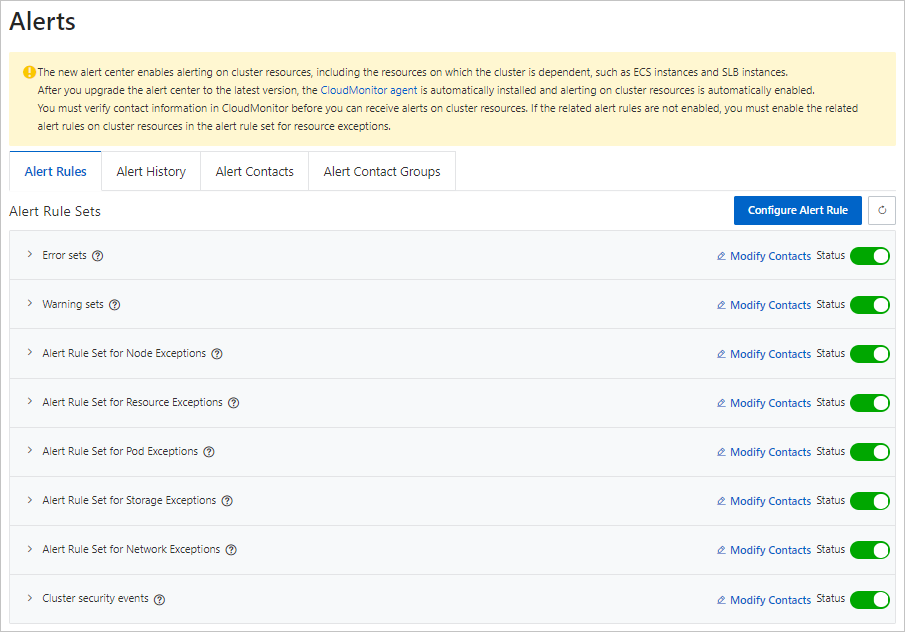 For more information, see Step 2: Configure alert rules.
For more information, see Step 2: Configure alert rules.
Step 2: Configure alert rules
After you create an ACK managed cluster or an ACK dedicated cluster, you can manage alert rules, alert contacts, and alert contact groups.
Log on to the ACK console.
In the left-side navigation pane of the ACK console, click Clusters.
On the Clusters page, find the cluster that you want to manage and click the name of the cluster or click Details in the Actions column. The details page of the cluster appears.
In the left-side navigation pane, choose .
Feature
Description
Alert Rules
By default, ACK provides an alert rule template that you can use to generate alerts based on exceptions and metrics.
Alert rules are classified into several alert rule sets. You can enable an alert rule set, disable an alert rule set, and configure multiple alert contact groups for an alert rule set.
An alert rule set contains multiple alert rules. Each alert rule corresponds to an alert item. You can create a YAML file to configure multiple alert rule sets in a cluster. You can also modify the YAML file to update alert rules.
For more information about how to configure alert rules by using a YAML file, see Configure alert rules by using CRDs.
For more information about the default alert rule template, see Default alert rule template.
Alert History
You can view up to 100 historical alerts. You can select an alert and click the link in the Alert Rule column to view rule details in the monitoring system. You can click Details to go to the resource page on which the alert is triggered. The alert may be triggered by an exception or an abnormal metric.
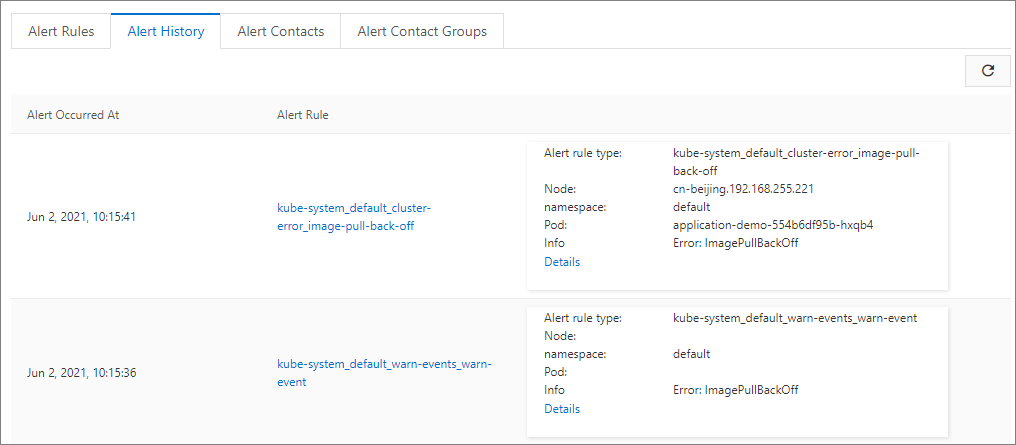
Alert Contacts
You can create, edit, or delete alert contacts.
The alert rule set for resource exceptions includes alert rules for basic node resources. Before an alert contact can receive alerts on basic cluster resources, the mobile phone number and email address of the contact must be verified in the CloudMonitor console. You can view and update information about an alert contact in the CloudMonitor console. If the verification has expired, delete the contact in the CloudMonitor console, and then refresh the Alert Contacts page in the ACK console.
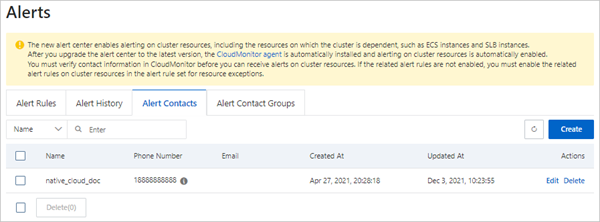
Alert Contact Groups
You can create, edit, or delete alert contact groups. If no alert contact group exists, the ACK console automatically creates a default alert contact group based on the information that you provided during registration.
On the Alert Rules tab, click Modify Contacts to specify the contact groups to which the alerts are sent. You can turn on or turn off Status to enable or disable the alert rule set.
Configure alert rules by using CRDs
If you enable the alerting feature, the system automatically creates a resource object of the AckAlertRule type in the kube-system namespace. The resource object contains the default alert rule template. You can use the resource object to configure alert rule sets.
Log on to the ACK console.
In the left-side navigation pane of the ACK console, click Clusters.
On the Clusters page, find the cluster that you want to manage and click the name of the cluster or click Details in the Actions column. The details page of the cluster appears.
In the left-side navigation pane, choose .
In the upper-right corner of the Alert Rules tab, click Configure Alert Rule. You can view the configuration of the AckAlertRule object and modify the YAML file to update the configuration.
Example:
apiVersion: alert.alibabacloud.com/v1beta1 kind: AckAlertRule metadata: name: default spec: groups: # The following code is a sample alert rule based on cluster events. - name: pod-exceptions # The name of the alert rule set. This parameter corresponds to the Group_Name field in the alert rule template. rules: - name: pod-oom # The name of the alert rule. type: event # The type of the alert rule, which corresponds to the Rule_Type parameter. Valid values: event and metric-cms. expression: sls.app.ack.pod.oom # The alert rule expression. If you set the rule type to event, the expression is set to the value of Rule_Expression_Id in the default alert rule template. enable: enable # The status of the alert rule. Valid values: enable and disable. - name: pod-failed type: event expression: sls.app.ack.pod.failed enable: enable # The following code is a sample alert rule for basic cluster resources. - name: res-exceptions # The name of the alert rule set. This parameter corresponds to the Group_Name field in the alert rule template. rules: - name: node_cpu_util_high # The name of the alert rule. type: metric-cms # The type of the alert rule, which corresponds to the Rule_Type parameter. Valid values: event and metric-cms. expression: cms.host.cpu.utilization # The alert rule expression. If you set the rule type to event, the expression is set to the value of Rule_Expression_Id in the default alert rule template. contactGroups: # The contact group that is associated with the alert rule. The contacts created by an Alibaba Cloud account are shared by all clusters within the account. enable: enable # The status of the alert rule. Valid values: enable and disable. thresholds: # The alert threshold. For more information, see the "Modify the alert threshold for basic cluster resources" section of this topic. - key: CMS_ESCALATIONS_CRITICAL_Threshold unit: percent value: '1'
Default alert rule template
ACK creates the default alert rules in the following conditions:
The default alert rules are enabled.
You go to the Alert Rules tab for the first time and the default alert rules are not enabled.
The following table describes the default alert rules.
Alert rule set | Alert rule | Description | Rule_Type | ACK_CR_Rule_Name | SLS_Event_ID |
Alert rule set for critical events in the cluster. | Errors | An alert is triggered when an error occurs in the cluster. | event | error-event | sls.app.ack.error |
Warnings | An alert is triggered when a warning occurs in the cluster, except for warnings that can be ignored. | event | warn-event | sls.app.ack.warn | |
Alert rule set for cluster exceptions | Docker process exceptions on nodes | An alert is triggered when a dockerd exception or a containerd exception occurs on a node. | event | docker-hang | sls.app.ack.docker.hang |
Evictions in the cluster | An alert is triggered when a pod is evicted. | event | eviction-event | sls.app.ack.eviction | |
GPU XID errors | An alert is triggered when a GPU XID error occurs. | event | gpu-xid-error | sls.app.ack.gpu.xid_error | |
Node changes to the unschedulable state | An alert is triggered when the status of a node changes to unschedulable. | event | node-down | sls.app.ack.node.down | |
Node restarts | An alert is triggered when a node restarts. | event | node-restart | sls.app.ack.node.restart | |
NTP service failures on nodes | An alert is triggered when the Network Time Protocol (NTP) service fails. | event | node-ntp-down | sls.app.ack.ntp.down | |
PLEG errors on nodes | An alert is triggered when a Lifecycle Event Generator (PLEG) error occurs on a node. | event | node-pleg-error | sls.app.ack.node.pleg_error | |
Process errors on nodes | An alert is triggered when a process error occurs on a node. | event | ps-hang | sls.app.ack.ps.hang | |
Alert rule set for resource exceptions | Node - CPU usage ≥ 85% | An alert is triggered when the CPU usage of a node exceeds the threshold. The default threshold is 85%. If the percentage of available CPU resources is less than 15%, the CPU resources reserved for components may become insufficient. For more information, see Resource reservation policy. Consequently, CPU throttling may be frequently triggered and processes may respond slowly. We recommend that you optimize the CPU usage or adjust the threshold at the earliest opportunity. For more information about how to adjust the threshold, see Modify the alert threshold for basic cluster resources. | metric-cms | node_cpu_util_high | cms.host.cpu.utilization |
Node - Memory usage ≥ 85% | An alert is triggered when the memory usage of a node exceeds the threshold. The default threshold is 85%. If the percentage of available memory resources is less than 15%, the memory resources reserved for components may become insufficient. For more information, see Resource reservation policy. In this scenario, kubelet forcibly evicts pods from the node. We recommend that you optimize the memory usage or adjust the threshold at the earliest opportunity. For more information about how to adjust the threshold, see Modify the alert threshold for basic cluster resources. | metric-cms | node_mem_util_high | cms.host.memory.utilization | |
Node - Disk usage ≥ 85% | An alert is triggered when the disk usage of a node exceeds the threshold. The default threshold is 85%. For more information about how to adjust the threshold, see Modify the alert threshold for basic cluster resources. | metric-cms | node_disk_util_high | cms.host.disk.utilization | |
Node - Usage of outbound public bandwidth ≥ 85% | An alert is triggered when the usage of the outbound public bandwidth of a node exceeds the threshold. The default threshold is 85%. For more information about how to adjust the threshold, see Modify the alert threshold for basic cluster resources. | metric-cms | node_public_net_util_high | cms.host.public.network.utilization | |
Node - Inode usage ≥ 85% | An alert is triggered when the inode usage of a node exceeds the threshold. The default threshold is 85%. For more information about how to adjust the threshold, see Modify the alert threshold for basic cluster resources. | metric-cms | node_fs_inode_util_high | cms.host.fs.inode.utilization | |
Resources - Usage of the maximum connections of an SLB instance ≥ 85% | An alert is triggered when the usage of the maximum number of connections of a Server Load Balancer (SLB) instance exceeds the threshold. The default threshold is 85%. Note This rule applies to all SLB instances that are created for the Kubernetes API server and Ingresses. For more information about how to adjust the threshold, see Modify the alert threshold for basic cluster resources. | metric-cms | slb_qps_util_high | cms.slb.qps.utilization | |
Resources - Usage of SLB outbound bandwidth ≥ 85% | An alert is triggered when the usage of the outbound bandwidth of an SLB instance exceeds the threshold. The default threshold is 85%. Note This rule applies to all SLB instances that are created for the Kubernetes API server and Ingresses. For more information about how to adjust the threshold, see Modify the alert threshold for basic cluster resources. | metric-cms | slb_traff_tx_util_high | cms.slb.traffic.tx.utilization | |
Resources - Usage of the maximum connections of an SLB instance ≥ 85% | An alert is triggered when the usage of the maximum number of connections of an SLB instance exceeds the threshold. The default threshold is 85%. Note This rule applies to all SLB instances that are created for the Kubernetes API server and Ingresses. For more information about how to adjust the threshold, see Modify the alert threshold for basic cluster resources. | metric-cms | slb_max_con_util_high | cms.slb.max.connection.utilization | |
Resources - Connection drops per second of the listeners of an SLB instance remains ≥ 1 | An alert is triggered when the number of connections dropped per second by the listeners of an SLB instance remains at 1 or more. The default threshold is 1. Note This rule applies to all SLB instances that are created for the Kubernetes API server and Ingresses. For more information about how to adjust the threshold, see Modify the alert threshold for basic cluster resources. | metric-cms | slb_drop_con_high | cms.slb.drop.connection | |
Excessive file handles on nodes | An alert is triggered when excessive file handles exist on a node. | event | node-fd-pressure | sls.app.ack.node.fd_pressure | |
Insufficient node disk space | An alert is triggered when the disk space of a node is insufficient. | event | node-disk-pressure | sls.app.ack.node.disk_pressure | |
Excessive processes on nodes | An alert is triggered when excessive processes run on a node. | event | node-pid-pressure | sls.app.ack.node.pid_pressure | |
Insufficient node resources for scheduling | An alert is triggered when a node has insufficient resources for scheduling. | event | node-res-insufficient | sls.app.ack.resource.insufficient | |
Insufficient node IP addresses | An alert is triggered when node IP addresses are insufficient. | event | node-ip-pressure | sls.app.ack.ip.not_enough | |
Alert rule set for pod exceptions | Pod OOM errors | An alert is triggered when an out of memory (OOM) error occurs in a pod. | event | pod-oom | sls.app.ack.pod.oom |
Pod restart failures | An alert is triggered when a pod fails to restart. | event | pod-failed | sls.app.ack.pod.failed | |
Image pull failures | An alert is triggered when an image fails to be pulled. | event | image-pull-back-off | sls.app.ack.image.pull_back_off | |
Alert rule set for O&M exceptions | No available SLB instance | An alert is triggered when an SLB instance fails to be created. In this case, submit a ticket to contact the ACK technical team. | event | slb-no-ava | sls.app.ack.ccm.no_ava_slb |
SLB instance update failures | An alert is triggered when an SLB instance fails to be updated. In this case, submit a ticket to contact the ACK technical team. | event | slb-sync-err | sls.app.ack.ccm.sync_slb_failed | |
SLB instance deletion failures | An alert is triggered when an SLB instance fails to be deleted. In this case, submit a ticket to contact the ACK technical team. | event | slb-del-err | sls.app.ack.ccm.del_slb_failed | |
Node deletion failures | An alert is triggered when a node fails to be deleted. In this case, submit a ticket to contact the ACK technical team. | event | node-del-err | sls.app.ack.ccm.del_node_failed | |
Node adding failures | An alert is triggered when a node fails to be added to the cluster. In this case, submit a ticket to contact the ACK technical team. | event | node-add-err | sls.app.ack.ccm.add_node_failed | |
Route creation failures | An alert is triggered when a cluster fails to create a route in the virtual private cloud (VPC). In this case, submit a ticket to contact the ACK technical team. | event | route-create-err | sls.app.ack.ccm.create_route_failed | |
Route update failures | An alert is triggered when a cluster fails to update the routes of the VPC. In this case, submit a ticket to contact the ACK technical team. | event | route-sync-err | sls.app.ack.ccm.sync_route_failed | |
Command execution failures in managed node pools | An alert is triggered when a node pool error occurs. In this case, submit a ticket to contact the ACK technical team. | event | nlc-run-cmd-err | sls.app.ack.nlc.run_command_fail | |
Node removal failures in managed node pools | An alert is triggered when a node pool error occurs. In this case, submit a ticket to contact the ACK technical team. | event | nlc-empty-cmd | sls.app.ack.nlc.empty_task_cmd | |
Unimplemented URL mode in managed node pools | An alert is triggered when a node pool error occurs. In this case, submit a ticket to contact the ACK technical team. | event | nlc-url-m-unimp | sls.app.ack.nlc.url_mode_unimpl | |
Unknown repairing operations in managed node pools | An alert is triggered when a node pool error occurs. In this case, submit a ticket to contact the ACK technical team. | event | nlc-opt-no-found | sls.app.ack.nlc.op_not_found | |
Node draining and removal failures in managed node pools | An alert is triggered when a node pool error occurs. In this case, submit a ticket to contact the ACK technical team. | event | nlc-des-node-err | sls.app.ack.nlc.destroy_node_fail | |
Node draining failures in managed node pools | An alert is triggered when a node in a managed node pool fails to be drained. In this case, submit a ticket to contact the ACK technical team. | event | nlc-drain-node-err | sls.app.ack.nlc.drain_node_fail | |
ECS restart timeouts in managed node pools | An alert is triggered when a node pool error occurs. In this case, submit a ticket to contact the ACK technical team. | event | nlc-restart-ecs-wait | sls.app.ack.nlc.restart_ecs_wait_fail | |
ECS restart failures in managed node pools | An alert is triggered when a node pool error occurs. In this case, submit a ticket to contact the ACK technical team. | event | nlc-restart-ecs-err | sls.app.ack.nlc.restart_ecs_fail | |
ECS reset failures in managed node pools | An alert is triggered when a node pool error occurs. In this case, submit a ticket to contact the ACK technical team. | event | nlc-reset-ecs-err | sls.app.ack.nlc.reset_ecs_fail | |
Auto-repair task failures in managed node pools | An alert is triggered when a node pool error occurs. In this case, submit a ticket to contact the ACK technical team. | event | nlc-sel-repair-err | sls.app.ack.nlc.repair_fail | |
Alert rule set for network exceptions | Invalid Terway resources | An alert is triggered when a Terway resource is invalid. In this case, submit a ticket to contact the ACK technical team. | event | terway-invalid-res | sls.app.ack.terway.invalid_resource |
IP allocation failures of Terway | An alert is triggered when an IP address fails to be allocated in Terway mode. In this case, submit a ticket to contact the ACK technical team. | event | terway-alloc-ip-err | sls.app.ack.terway.alloc_ip_fail | |
Ingress bandwidth configuration parsing failures | An alert is triggered when the bandwidth configuration of an Ingress fails to be parsed. In this case, submit a ticket to contact the ACK technical team. | event | terway-parse-err | sls.app.ack.terway.parse_fail | |
Network resource allocation failures of Terway | An alert is triggered when a network resource fails to be allocated in Terway mode. In this case, submit a ticket to contact the ACK technical team. | event | terway-alloc-res-err | sls.app.ack.terway.allocate_failure | |
Network resource reclaiming failures of Terway | An alert is triggered when a network resource fails to be reclaimed in Terway mode. In this case, submit a ticket to contact the ACK technical team. | event | terway-dispose-err | sls.app.ack.terway.dispose_failure | |
Terway virtual mode changes | An alert is triggered when the Terway virtual mode is changed. | event | terway-virt-mod-err | sls.app.ack.terway.virtual_mode_change | |
Pod IP checks executed by Terway | An alert is triggered when a pod IP is checked in Terway mode. | event | terway-ip-check | sls.app.ack.terway.config_check | |
Ingress configuration reload failures | An alert is triggered when the configuration of an Ingress fails to be reloaded. In this case, check whether the Ingress configuration is valid. | event | ingress-reload-err | sls.app.ack.ingress.err_reload_nginx | |
Alert rule set for storage exceptions | Cloud disk size less than 20 GiB | ACK does not allow you to mount a disk of less than 20 GiB. You can check the sizes of the disks that are attached to your cluster. | event | csi_invalid_size | sls.app.ack.csi.invalid_disk_size |
Subscription cloud disks cannot be mounted | ACK does not allow you to mount a subscription disk. You can check the billing methods of the disks that are attached to your cluster. | event | csi_not_portable | sls.app.ack.csi.disk_not_portable | |
Mount target unmounting failures because the mount target is being used | An alert is triggered when an unmount failure occurs because the mount target is in use. | event | csi_device_busy | sls.app.ack.csi.deivce_busy | |
No available cloud disk | An alert is triggered when no disk is available. In this case, submit a ticket to contact the ACK technical team. | event | csi_no_ava_disk | sls.app.ack.csi.no_ava_disk | |
I/O hangs of cloud disks | An alert is triggered when I/O hangs occur on a disk. In this case, submit a ticket to contact the ACK technical team. | event | csi_disk_iohang | sls.app.ack.csi.disk_iohang | |
Slow I/O rate of PVC used to mount cloud disks | An alert is triggered when the I/O of a disk that is mounted by using a persistent volume claim (PVC) is slow. In this case, submit a ticket to contact the ACK technical team. | event | csi_latency_high | sls.app.ack.csi.latency_too_high | |
Disk usage exceeds the threshold | An alert is triggered when the usage of a disk exceeds the specified threshold. You can check the usage of a disk that is mounted to your cluster. | event | disk_space_press | sls.app.ack.csi.no_enough_disk_space | |
Alert rule set for cluster security events | High-risk configurations detected in inspections | An alert is triggered when a high-risk configuration is detected during a cluster inspection. In this case, submit a ticket to contact the ACK technical team. | event | si-c-a-risk | sls.app.ack.si.config_audit_high_risk |
Enable alert management for an ACK dedicated cluster
Before you can enable the alert management feature for a dedicated cluster, you must grant the required permissions to the cluster.
The system automatically grants ACK managed clusters the permissions to access resources that are related to the alerting feature of Simple Log Service.
Grant an ACK dedicated cluster the permissions to access resources that are related to the alerting feature of Simple Log Service and Managed Service for Prometheus. For more information, see Use custom policies to grant permissions to a RAM user and Overview.
Log on to the ACK console.
In the left-side navigation pane of the ACK console, click Clusters.
On the Clusters page, find the cluster that you want to manage and click the name of the cluster or click Details in the Actions column. The details page of the cluster appears.
On the Cluster Information page, click the Cluster Resources tab and then click the link to the right of Worker RAM Role to go to the Resource Access Management (RAM) console.

On the Permissions tab, click the name of the policy that you want to modify in the Policy column.
On the Policy Document tab, click Modify Policy Document and add the following content:
{ "Action": [ "log:*", "arms:*", "cms:*", "cs:UpdateContactGroup" ], "Resource": [ "*" ], "Effect": "Allow" }Click Next to edit policy information and then click OK.
Check the log to verify that the permissions are granted.
In the ACK console, click the cluster that you want to manage. In the left-side navigation pane, choose .
Set Namespace to kube-system, find alicloud-monitor-controller in the Deployments list, and then click the link in the Name column.
Click the Logs tab and verify that the log content that indicates successful authorization is displayed.
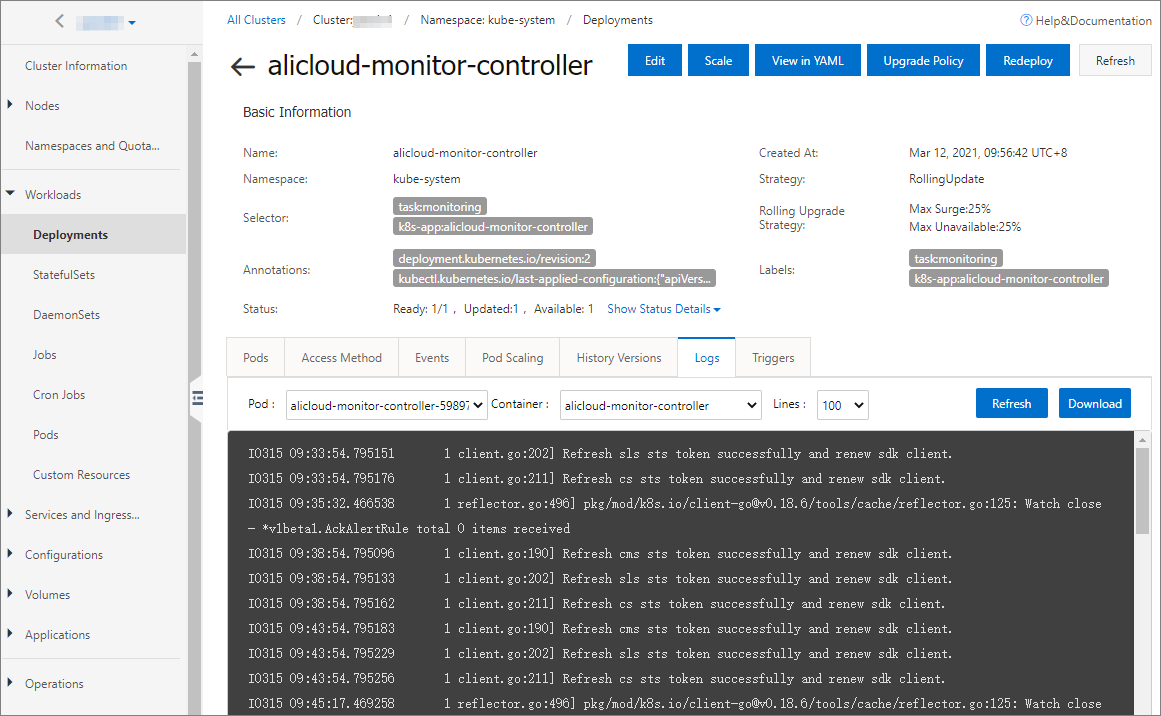
Modify the alert threshold for basic cluster resources
If Rule_Type is set to metric-cms for an alert rule, the metrics are synchronized from CloudMonitor. You can modify the alert threshold of the alert rule by using a CRD object. For more information, see Configure alert rules by using CRDs.
In this example, the CPU usage alert rule is modified by using a CRD object. The thresholds parameter is used to specify the alert threshold, the number of times that the CPU usage exceeds the threshold, and the silence period.
apiVersion: alert.alibabacloud.com/v1beta1
kind: AckAlertRule
metadata:
name: default
spec:
groups:
# The following code is a sample alert rule for basic cluster resources.
- name: res-exceptions # The name of the alert rule set. This parameter corresponds to the Group_Name field in the alert rule template.
rules:
- name: node_cpu_util_high # The name of the alert rule.
type: metric-cms # The type of the alert rule. Valid values: event and metric-cms.
expression: cms.host.cpu.utilization # The alert rule expression. If you set the rule type to event, the expression is set to the value of Rule_Expression_Id in the default alert rule template.
contactGroups: # The contact group associated with the alert rule. You can add contact groups in the ACK console. The contacts created by an Alibaba Cloud account are shared by all clusters within the account.
enable: enable # The status of the alert rule. Valid values: enable and disable.
thresholds: # The alert threshold. For more information, see Configure alert rules by using CRDs.
- key: CMS_ESCALATIONS_CRITICAL_Threshold
unit: percent
value: '1'
- key: CMS_ESCALATIONS_CRITICAL_Times
value: '3'
- key: CMS_RULE_SILENCE_SEC
value: '900' Parameter | Description | Default |
| The alert threshold.
This parameter is required. If you leave this parameter empty, the modification does not take effect and the alert rule is disabled. | The default value is the same as the default value specified in the default alert rule template. |
| The number of times that the alert threshold is exceeded before an alert is triggered. This parameter is optional. If you leave this parameter empty, the default value is used. | 3 |
| The silence period after an alert is triggered. This parameter is used to prevent frequent alerting. Unit: seconds. This parameter is optional. If you leave this parameter empty, the default value is used. | 900 |
View alert rules in the corresponding monitoring system
After you enable the alert rules of alert management, the status of the alert rules that you enabled is updated on the Alert Rules tab. You can click Advanced Settings to go to the rule details page of the corresponding monitoring system such as ARMS, Simple Log Service, and CloudMonitor. You can also go to the console of the corresponding monitoring system and view the details of the alert rules.
View the alert rules in Simple Log Service:
Log on to the Simple Log Service console.
Find and click the Simple Log Service project that is used by the cluster. The default name of the Simple Log Service project used by the cluster is K8s-log-{{clusterId}}.
In the left-side navigation pane, click the
 icon. On the Alert Center page, click the Alert Rules/Incidents tab to view the rules that are enabled. Select ACK for Type to filter the default alert rules that are updated by the alert management feature of ACK. Note
icon. On the Alert Center page, click the Alert Rules/Incidents tab to view the rules that are enabled. Select ACK for Type to filter the default alert rules that are updated by the alert management feature of ACK. NoteYou must make sure that the alert rules of alert management are enabled. Otherwise, the ACK option is not displayed in the Type field.
View the alert rules in CloudMonitor:
Log on to the CloudMonitor console.
In the left-side navigation pane, click Application Groups. On the Application Groups page, click the Resource Tag Rules tab.
In the Rule Description column, search for Resource Tag Key:ack.aliyun.com, Tag Value:Equal To is <Cluster ID>.
View the alert rules in Managed Service for Prometheus: Log on to the ARMS console and view the alert rules that are updated by the alert management feature of ACK. The name of each alert rule displayed in the Managed Service for Prometheus console is in the
Alert rule name_Cluster nameformat.
FAQ
What do I do if I fail to update an alert rule and the following error message is returned: The Project does not exist : k8s-log-xxx?
Symptom:
The system returns an error message, as shown in the following figure.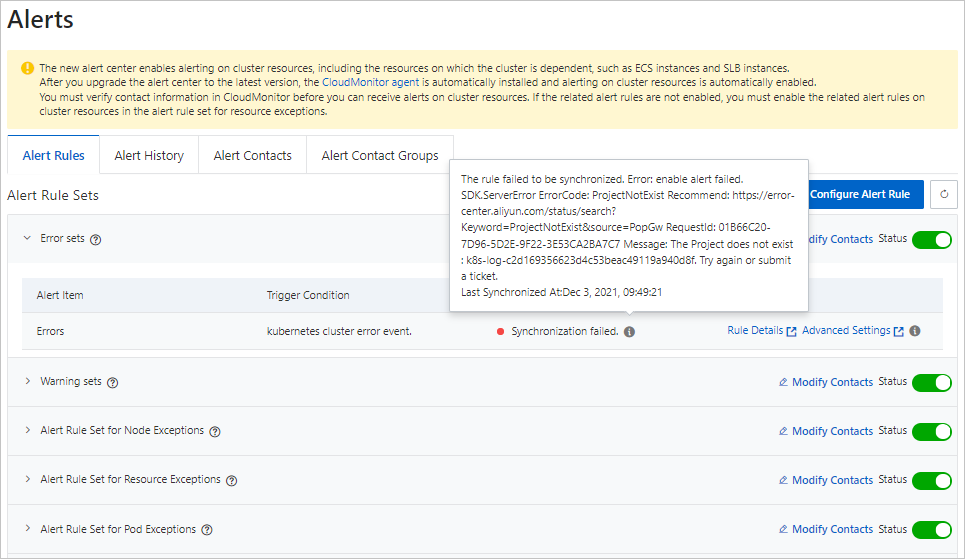
Cause:
You did not create an event center in Simple Log Service for your cluster.
Solution:
Go to the Simple Log Service console. Check whether the number of projects has reached the quota limit. If the quota limit is reached, delete excessive projects or submit a ticket to apply for a quota increase. For more information about how to delete a Simple Log Service project, see Manage a project.
Reinstall ack-node-problem-detector.
In the left-side navigation pane of the cluster details page in the ACK console, choose .
If you want to reinstall ack-node-problem-detector by using a YAML file, perform the following steps to obtain a copy of the YAML template of ack-node-problem-detector:
On the Helm page, find ack-node-problem-detector and click Update in the Actions column. After ack-node-problem-detector is updated, click View Details in the Actions column. On the details page of ack-node-problem-detector, select a resource and click View in YAML to copy the YAML content to your on-premises machine. Perform the same operation for each resource to obtain a copy of the YAML template.
On the Helm page, select ack-node-problem-detector and click Delete in the Actions column.
In the left-side navigation pane of the details page, choose .
Click the Log and Monitoring tab, find ack-node-problem-detector, and then click Install.
In the Note message, confirm the versions of the plug-ins and click OK. After ack-node-problem-detector is installed, the word "Installed" and the version information are displayed in the ack-node-problem-detector section.
What do I do if I fail to update an alert rule because no contact group subscribes to the alert rule?
Symptom:
The system returns an error message, as shown in the following figure.
The following error message is returned: this rule have no xxx contact groups reference.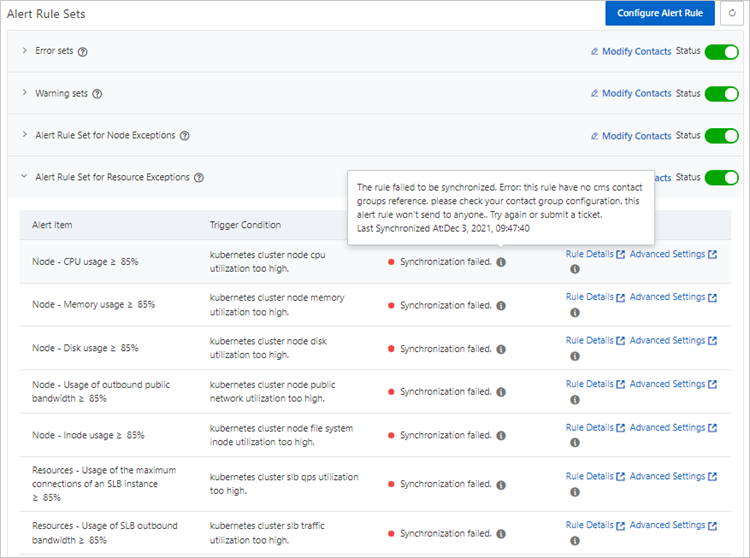
Cause:
No contact group subscribes to the alert rule.
Solution:
Create a contact group and add contacts.
Find the alert rule and click Modify Contacts. In the Modify Contacts panel, add the contact group that you created as the subscriber.
For more information, see Set up alerting.